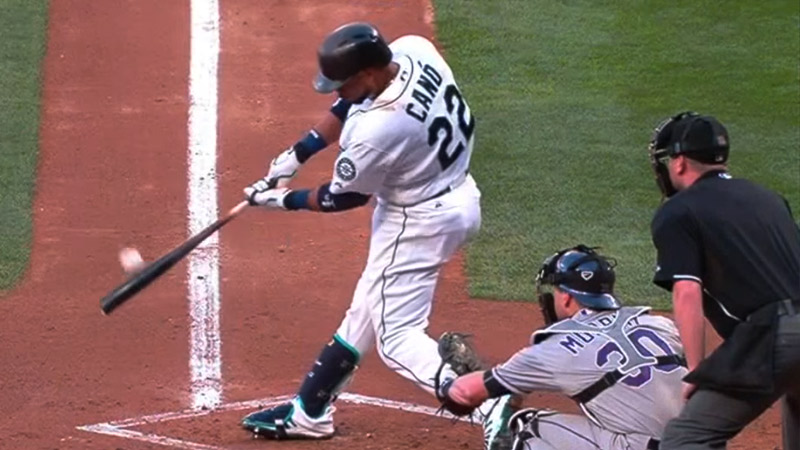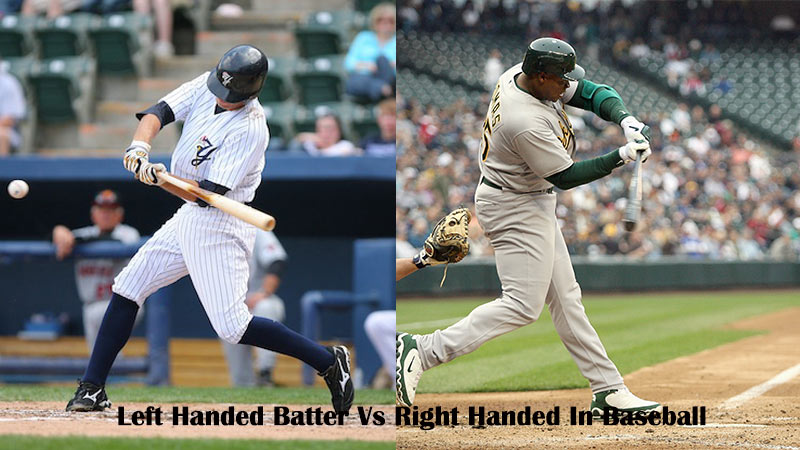In the world of baseball, the distinction between left-handed and right-handed batters plays a pivotal role in the dynamics of the game. This fundamental difference goes beyond the obvious stance variation.
Left-handed batters, by nature, present a unique challenge to right-handed pitchers, often showcasing an advantage when facing them. Their positioning in the batter’s box affects not only their approach but also the strategies employed by the opposing team.
Conversely, right-handed batters hold their own set of advantages, especially when confronting left-handed pitchers. These disparities extend to fielding positions, base running, and even the intricate chess match between batter and pitcher.
Understanding these disparities is key to comprehending the intricate strategies that make baseball such a captivating sport.
Left-Handed Batter vs. Right-Handed In Baseball? 20 Comparison
Let’s summarize the key differences between left-handed batters and right-handed batters in baseball:
1. Batting Stance
- Left-Handed Batter: A left-handed batter stands on the left side of the batter’s box, with their right side facing the pitcher.
- Right-Handed Batter: A right-handed batter stands on the right side of the batter’s box, with their left side facing the pitcher.
2. Dominant Eye
- Left-Handed Batter: Left-handed batters are often right-eye dominant, meaning their right eye is their dominant eye for tracking the ball.
- Right-Handed Batter: Right-handed batters are often left-eye dominant, with their left eye being the dominant one for tracking the ball.
3. Hitting Pitches
- Left-Handed Batter: Left-handed batters generally have an advantage when facing right-handed pitchers, as they are positioned closer to the pitcher’s throwing arm, making it potentially easier to track the ball.
- Right-Handed Batter: Right-handed batters tend to perform better against left-handed pitchers because they are better positioned to see the ball coming from the opposite side of the pitcher’s body.
4. Fielding Advantage
- Left-Handed Batter: Left-handed batters often have a fielding advantage at first base due to their ability to stretch and catch throws more naturally with their glove hand. They also have an advantage in right field, where a strong throwing arm is beneficial.
- Right-Handed Batter: Right-handed batters have a fielding advantage at third base because they can make quicker throws to first base after fielding ground balls. Additionally, they are often preferred at shortstop (SS) due to the positioning of that infield position.
5. Pulling the Ball
- Left-Handed Batter: Left-handed batters are more likely to pull the ball, meaning they hit the ball to the side of the field that corresponds to their stance (right field for left-handed batters). They may have more power when pulling the ball.
- Right-Handed Batter: Right-handed batters are more likely to hit the ball to the opposite field (left field for right-handed batters) and may use the whole field for hitting. They may have more power when hitting the opposite field.
6. Angle to First Base
- Left-Handed Batter: Left-handed batters have a more direct angle to first base when running because they are already closer to the base when they hit the ball.
- Right-Handed Batter: Right-handed batters have a less direct angle to first base when running, as they have to take a step or two towards first base after hitting the ball.
7. Inside Pitches
- Left-Handed Batter: Left-handed batters can be more vulnerable to inside pitches, especially from right-handed pitchers, because the pitch moves towards their body, making it challenging to react quickly.
- Right-Handed Batter: Right-handed batters often handle inside pitches better, as they are naturally positioned to turn on pitches coming from right-handed pitchers.
8. Speed to First Base
- Left-Handed Batter: Left-handed batters typically have a shorter distance to run to first base after making contact with the ball, which can lead to faster times to first base.
- Right-Handed Batter: Right-handed batters have a slightly longer distance to run to first base after hitting the ball, which may result in slightly slower times to first base compared to left-handed batters.
9. Pickoff Moves
- Left-Handed Batter: Left-handed batters are often considered easier targets for pickoff attempts by right-handed pitchers because their body position at first base provides a clearer throwing lane for the pitcher.
- Right-Handed Batter: Right-handed batters are typically harder to pick off by right-handed pitchers because their positioning at first base may obstruct the pitcher’s throwing path.
10. Facing Lefty Pitchers
- Left-Handed Batter: Left-handed batters may face challenges when batting against left-handed pitchers because the ball can be harder to pick up due to it coming from the same side, leading to reduced effectiveness.
- Right-Handed Batter: Right-handed batters often have an advantage when facing left-handed pitchers because the ball comes from the opposite side, making it more visible and potentially easier to track.
11. Facing Righty Pitchers
- Left-Handed Batter: Left-handed batters tend to perform better when facing right-handed pitchers because the pitch trajectory is moving away from them, allowing for better visibility and timing.
- Right-Handed Batter: Right-handed batters may face challenges when batting against right-handed pitchers because the pitch trajectory can move in toward them, making it potentially more difficult to react.
12. Fielding Position
- Left-Handed Batter: Left-handed batters often excel in the outfield, particularly in right field, because their glove hand (left hand) is facing the infield, making it easier to catch fly balls and make accurate throws to the infield.
- Right-Handed Batter: Right-handed batters are often preferred in left field due to their glove hand (right hand) being closer to the infield, facilitating quicker throws to the infield bases. They are also frequently found in positions like shortstop (SS) and second base (2B) in the infield.
13. Hitting Mechanics
- Left-Handed Batter: Left-handed batters have different hitting mechanics compared to right-handed batters. They typically have a shorter distance to the strike zone, which can make it easier for them to reach outside pitches but potentially more challenging to handle inside pitches.
- Right-Handed Batter: Right-handed batters have their hitting mechanics adjusted to their stance, typically allowing them to cover the inside part of the plate better but potentially making them reach for outside pitches.
14. Line of Sight
- Left-Handed Batter: Left-handed batters have a different line of sight when facing the pitcher. They see the pitcher’s throwing arm from the opposite side compared to right-handed batters, which can influence their timing and reaction.
- Right-Handed Batter: Right-handed batters have a line of sight that matches the pitcher’s throwing arm side, making it potentially easier to pick up the pitch’s release point and movement.
15. Catcher’s View
- Left-Handed Batter: When a left-handed batter is at the plate, the catcher has a clearer view of the field, including the pitcher, second base, and potentially the runner at first base. This can be advantageous for signaling and communication with the infield.
- Right-Handed Batter: When a right-handed batter is at the plate, the catcher’s view can be somewhat obstructed by the batter’s body, making it slightly more challenging to see the field, particularly the pitcher and second base.
16. Infield Shifts
- Left-Handed Batter: Left-handed batters are less likely to face extreme infield shifts, as their tendency to pull the ball to right field means that fielders usually stay closer to their regular positions.
- Right-Handed Batter: Right-handed batters are more likely to face extreme infield shifts, with fielders moving significantly to one side of the field (usually the pull side) to defend against their hitting tendencies.
17. Base Running
- Left-Handed Batter: Left-handed batters often have an advantage in base running, particularly stealing bases, due to their proximity to first base when they hit the ball and their angle towards second base, which can provide a quicker start.
- Right-Handed Batter: Right-handed batters may have a slightly longer path to first base after hitting the ball, which can make them marginally slower in base running, especially when trying to steal bases.
18. Home Run Hitting
- Left-Handed Batter: Left-handed batters often have an advantage in hitting home runs to right field due to their natural swing path. They can use the shorter distance to the right-field fence in many ballparks to their advantage.
- Right-Handed Batter: Right-handed batters tend to have an advantage in hitting home runs to left field because of their swing path. Ballparks with shorter distances to the left-field fence can benefit right-handed power hitters.
19. Pitcher’s Strategy
- Left-Handed Batter: Pitchers often adjust their strategy when facing left-handed batters, as they may need to focus on pitches that break away from the batter (e.g., sliders or curveballs) to exploit the batter’s swing tendencies.
- Right-Handed Batter: Pitchers adjust their strategy when facing right-handed batters by using pitches that break in towards the batter (e.g., cutters or sinkers) to take advantage of their natural swing path.
20. Defensive Relevance
- Left-Handed Batter: Left-handed batters are more defensively relevant in positions such as first base (1B) and the outfield, where their throwing arm (right arm) is an asset for making accurate throws to other bases.
- Right-Handed Batter: Right-handed batters are more defensively relevant in positions like third base (3B), shortstop (SS), and second base (2B), where their throwing arm (left arm) allows for quicker throws to first base.
Do Left-handed Batters Have an Advantage Over Right-handed Pitchers?
There is no scientific evidence to support the idea that left-handed batters have an advantage over right-handed pitchers. However, some people believe this to be the case because they claim that a lefty’s hand is more natural when it comes to hitting balls in the air.

Source: behrend
Right-handed hitters tend to do better against lefty pitchers
Lefty hitters tend to do better against righty pitchers in the majors, but platoon splits generally hold true for both batters and pitchers. This is because right-handed batters have a natural advantage when batting against left-handed pitching, while lefties have an advantage when hitting against right-handers.
Do Left-handed Batters Have an Advantage Over Right-handed Pitchers?
There are anecdotal reports that some left-handed batters can hit RHPs harder than RHBs – however, this has not been scientifically proven yet.
Platoon splits generally hold true for both batter and pitcher.
What is the Difference Between Left and Right-handed Hitters?
Left-handed hitters are usually better at hitting left-handed pitchers, and right-handed hitters are usually better at hitting right-handed pitchers. This is because most people have a natural bias towards their dominant hand.
- Left-handed hitters have an advantage over right-handed hitters when it comes to batting. Being close to first base gives them a better chance of making the catch, and every year there are a few plays that left-handers lose by half a step due to this positioning difference.
- Some pitchers prefer to pitch left-handed batters with their fastballs because they know they will be closer to first base, giving them an edge in hitting against these players.
- When you swing your bat with your left hand, you are one step closer to 1st base than when you hit with your right hand.
This extra distance can cause some batted balls that would normally go for hits or doubles off of a pitcher’s shoulder or down the third baseman’s alley instead sail past him for an error or single in order for Lefty slugger Manny Ramirez to score from first on an RBI ground out.
Do Lefties Have an Advantage in Baseball?
There is some evidence that left-handed batters may have an advantage in baseball. This is because they are more likely to hit the ball to the opposite field.
Lefties also tend to use their stronger hand more often when batting, which can help them get better contact with the ball. Left-handed batters have an advantage in batting because they bats are swung from the same side as their throwing arm.
Lefties are better at throwing because they use a different muscle group when they throw than right-handers do. This means that lefties can put more power behind their throws, which can help them hit balls farther than right-handers. Left-handed pitchers also tend to be more effective on the mound, due to their ability to generate more velocity with their pitches.
Are Left-handed Hitters Better?
There is no definitive answer to this question, as it depends on a number of factors. However, some studies suggest that left-handed hitters have an advantage over right-handed hitters when it comes to hitting the ball in the air.

This may be because they are more able to generate power with their opposite hand.
Left-handed Hitters Enjoy a Platoon Advantage
Left-handed hitters have an advantage when it comes to facing right-handed pitchers. This is because lefties are more likely to be in the batting lineup than righties and, as a result, face fewer batters per game.
When they do face a pitcher who is throwing lefty-style, left-handers tend to hit better than right-handed hitters. In fact, according to research compiled by ESPN The Magazine, lefties’ slugging percentage tends to be higher against southpaws.
The Advantage is More Pronounced for Left-handers
For some players, this platoon advantage can be quite significant.
According to studies conducted by Hitters Lab and Baseball Prospectus, lefties slugging percentage is almost 50% higher when they bat against same-handed pitchers compared with opposite-handed pitchers (compared with their performance against other types of pitching).
Why Do Left-handed Hitters Pull the Ball More?
Left-handed hitters have an advantage in rotation, which allows them to pull batted balls more often than right-handed hitters. The physics of a hit plays into a left-handed hitter’s ability to pull the ball more often.
In order to make contact with the ball, lefties need to rotate their wrists differently than righties do and this leads to more pulling batted balls.
Finally, teams that are designed specifically for left-handed hitters (such as those played in The Big Leagues) tend to excel at pulling batted balls more often than teams that are not tailored towards lefty batters.
Why Do Some Righties Bat Lefty?
There might be an advantage to batting left-handed. Right-handed players may enjoy a biomechanical advantage because of the leverage provided by their throwing arm.
Bat control could be lower for righties due to the leverage they have with their throwing arm, resulting in an edge over lefties on the diamond.
Why Do Lefties Not Play Shortstop?
Left-handed catchers and shortstops have less range of motion than righties, which can limit their mobility while playing baseball. Range of motion is key to a catcher’s ability to throw the ball where it needs to be, so they often require more years of training than batters in general.
As a result, many top prospects choose shortstop over other positions as they develop due to its difficulty for lefties.
The position of shortstop is particularly difficult for left-handed players because they must cover ground across three bases when batting from the middle infield position – this makes it one of the least desirable positions for them to play on a regular basis at high levels of competition.
Though left-handed catchers and shortstops do exist at lower levels of competition, their lackluster career paths typically lead them toward other positions instead.
To Recap
The distinction between left-handed and right-handed batters in baseball extends beyond their stance. Left-handed batters tend to excel against right-handed pitchers, have a more direct path to first base, and can pose challenges for catchers with their clear line of sight.
They may struggle with inside pitches. Right-handed batters often perform better against left-handed pitchers, face more infield shifts, and may be preferred at positions like shortstop.
While they have a slightly longer route to first base, their pickoff resistance and ability to handle inside pitches are advantages. Both left-handed and right-handed batters bring unique skills and strategic considerations to the game.







